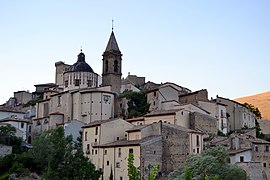Cocullo
| Cocullo | ||
|---|---|---|

|
|
|
| Country | Italy | |
| region | Abruzzo | |
| province | L'Aquila (AQ) | |
| Coordinates | 42 ° 2 ' N , 13 ° 46' E | |
| height | 900 m slm | |
| surface | 31 km² | |
| Residents | 212 (Dec. 31, 2019) | |
| Population density | 7 inhabitants / km² | |
| Post Code | 67030 | |
| prefix | 0864 | |
| ISTAT number | 066037 | |
| Popular name | Cocullesi | |
| Patron saint | Dominic of Sora | |
| Website | Cocullo | |
 View of Cocullo |
||
Cocullo is an Italian municipality and a mountain village with 212 inhabitants (as of December 31, 2019) in a valley in Abruzzo in Italy , about 20 kilometers from Sulmona .
Procession of St. Dominic of Sora
The village with a few hundred inhabitants preserves one of the oldest and strangest customs in Europe.
On May 1st every year since 2012 (in the past it took place on the first Thursday in May) thousands of people from all over Italy attend a celebration in honor of St. Dominic of Sora , a Benedictine monk from Umbria born in 951 . The hermit and wandering monk were already considered miraculous during their lifetime, whereby the miracles almost all have to do with the defense against bears, wolves and above all snakes. In the past, the pilgrims were people from the surrounding region, in which traditional costumes were still worn until the 1950s .
At the festival in honor of the Holy Abbot St. Dominic, his life-size bearded statue in a black coat, holding a staff in his right hand and a horseshoe in his left hand, is carried from the baroque church in a procession through the village and back again.
The young men and girls of the village collect hundreds of snakes for this procession in the surrounding rocky mountains, with which the statue is hung over and over at the beginning of the procession. A large number of snakes are also carried around the neck and arms of the serpari (snake catchers ) during worship and procession. During the service, the altar is flanked by two young women from the village, each of whom is balancing a large basket with large, hoop-shaped loaves of bread adorned with red and white silk and covered with carnations and cyclamen. The women also accompany the procession. Before the procession, a light red and a green banner are carried, to which banknotes have been pinned as offerings. The procession then begins with a song sung by a village girl in the dialect of Abruzzo. Following the banners are the priests, one of whom is carrying a cylindrical silver reliquary with a tooth of the saint. Then the two women with the bread baskets follow, then a chapel and finally the bearers of the statue of St. Dominic. The statue hung with snakes is accompanied by teenagers with hands full of snakes. The girls in the village used to stand on the roofs with snakes in their hands, greeting the procession. During the procession, all the bells ring, there is applause and cheers. The queues are removed when returning to the church.
In the past, as the travel writer Patrick Leigh Fermor reports, the animals , which were still frozen under rocks, were made to bite into a piece of cloth, where they squirted out their poison and tore out their fangs with the piece of cloth. The animals were sewn into goat skin for storage until the festival or they were stowed in vessels. After the procession they were sold.
Today, non-poisonous snakes such as Aesculapian snakes are collected and released after the procession.
It is believed that the inhabitants of Cocullos adopted this custom from their warlike ancestors, the Martians tribe , who were reportedly snake worshipers , snake charmers and magicians.
Some researchers see parallels with the fertility rites of the Agathos daimon .
Viticulture
Near the town of vines are varieties Montepulciano for the DOC - wine Montepulciano d'Abruzzo grown.
literature
- Walther Kabel : A snake procession . In: Library of entertainment and knowledge , year 1914, fourth volume, pp. 224–226; on Wikisource
- Patrick Leigh Fermor : The Snakes of St. Dominic (1953). In: Die Welt , July 1, 2006, supplement “Literary World”; German first translation
- Alfonso Maria Di Nola: Quattro note sul culto cucullese di San Domenico Abate . In: Rivista abruzzese , 34/1981, pp. 193-200
- Alfonso Maria Di Nola: Attraverso la storia delle religioni . Di Renzo Editore, 1996.
Web links
- Dominikus von Sora in the Ecumenical Lexicon of Saints (link because of the picture. Text is probably wrong because Cocullo was not an Etruscan city.)
- The Martians as snake tamers . uni-mannheim.de
Individual evidence
- ↑ Statistiche demografiche ISTAT. Monthly population statistics of the Istituto Nazionale di Statistica , as of December 31 of 2019.
- ↑ Spiegel Online : The Village of Snakes , May 3, 2010, accessed September 10, 2018


